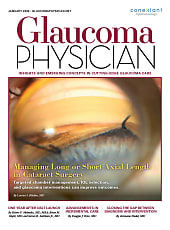WITH THE APPROVAL OF VUITY, the forward progress of and extensive clinical data surrounding other pipeline pharmaceuticals, and the continuing improvements in other presbyopia-correcting technologies, new opportunities are available to treat our presbyopia patients. Having more and more tools in the toolbox is giving doctors the ability to individualize different presbyopia-correcting options to best fit our patients’ unique near vision needs, activities, and lifestyles. Although there is no silver bullet, the expansion of options is definitely giving us a larger arsenal.
One might be able to compare this expansion to what we’ve seen in glaucoma care and the integration and evolution of MIGS. Although there remains much work to be done, we feel that presbyopia care is on a similar trajectory. Whether it be IOLs, pharmaceuticals, contact lenses, laser vision correction, or other technologies on the near horizon (allograft inlays, laser scleral microporation, peripheral corneal crosslinking), these options will continue to play off each other, expanding the opportunities for the early to the more advanced presbyopes who are at different stages of dysfunctional lens syndrome. We are also excited to see what “off-label” benefits these technologies may offer, as we continue to maximize the visual system.
As always, the contributors and editorial board members of Presbyopia Physician continue to deliver some excellent, practical clinical perspectives surrounding the treatment of presbyopia. We can’t thank these leaders in the professions enough for their perspectives and clinical insights.
Much of this issue focuses on Vuity ‑ what doctors are seeing as they roll out this drop option for their patients. Included are thoughts on how to approach appropriate patients and how to identify ideal, and less than ideal, candidates for this treatment option. An article on potential retinal complications explains why certain patients may be in that “less than ideal” group and require extra counseling.
There are other physiologic changes that occur naturally as patients approach the presbyopia age range. These sometimes interrelated conditions are discussed here in context of overall patient wellness, and a “back-to-basics” article regarding the physiology of presbyopia is presented. We also have a look at how one industry expert views the current activity in presbyopia correction, an update on corneal inlays (lenticules), and some thoughts on how emerging technologies may allow a longtime stalwart technique of monovision to be modernized. ■
Chief Co-Editors
Elizabeth Yeu, MD and Jacob Lang, OD










